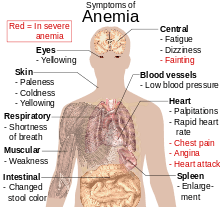Hemoglobinemia
| Hemoglobinemia | |
|---|---|
 | |
| Hemoglobin[1] |
Hemoglobinemia (British Haemoglobinaemia) is a medical condition in which there is an excess of hemoglobin in the blood plasma, sometimes abbreviated as Hb. This is an effect of intravascular hemolysis, in which hemoglobin separates from red blood cells, a form of anemia.
Hemoglobinemia can be caused by intrinisic or extrinsic factors. When hemoglobinemia is internally caused, it is a result of recessive genetic defects that cause the red blood cells to lyse, letting the hemoglobin spill out of the cell into the blood plasma. In intravascular hemolysis, hemoglobin is released and binds with haptoglobin. This causes haptoglobin levels to decrease; once haptoglobin is saturated, excess hemoglobin is filtered in the kidney and reabsorbed in the proximal tubules. In externally caused hemoglobinemia, an outside attacker acts as an antibody against the red blood cells. This can cause the cells to be destroyed and their hemoglobin released.In extravascular hemolysis, red blood cells are phagocytized by macrophages in the spleen and liver.[2]
Causes
There are other causes besides what happens within the body in the blood cells. Other factors that can cause an excess amount of hemoglobin are:
- Smoking(which may result in low blood oxygen levels)
- Higher altitudes where your red blood cell production naturally increases to compensate for the lower oxygen supply there
Specific disorders or other factors that may cause a high hemoglobin count include:
- COPD (chronic obstructive pulmonary disease)
- Dehydration
- Emphysema
- Heart failure
- Kidney cancer
- Liver cancer
- Other types of heart disease
- Other types of lung disease
- Polycythemia vera[3]
Diagnosis
Normal hemoglobin levels
Normal hemoglobin levels correlate with the person's age and sex. Levels can vary between different testing systems and under their doctor's consultation. A hemoglobin test measures the amount of hemoglobin in your blood. If a hemoglobin tests shows that a person's levels are below normal, it means they have a low red blood cell count, which is known as anemia. If the test shows higher levels than normal, it means they have hemoglobinemia.
The normal range for hemoglobin is:
Treatment
High hemoglobin levels are a rare occurrence but is usually treated as a symptom for an underling disease. Consulting a doctor is the best treatment, so he/she can diagnose your illness and give a recommended treatment plan to lower hemoglobin levels back to normal.
Doctors will test hemoglobin A1c levels to determine how high they are and to determine if blood glucose is very high. This requires a doctor to draw blood to send to the lab. Dietitians recommend diets that can help regulate this:
- Carbohydrate-counting diet: Carbs convert into glucose once they enter the bloodstream; measuring carb portions and keep a chart in order to monitor carbohydrate intake.
- Carbohydrate-exchange diet: In this diet, foods are separated into categories (carbohydrates, fats, meats, cheeses, etc.). An exchange is known as one food serving, and each exchange will have a specific amount of carbs, fats, and proteins. Exchanging with a food type in the same group will not affect blood glucose.
- Glycemic index diet: For this diet, food is categorised according to how it maintains or increases blood glucose and hemoglobin A1c levels; low glycemic foods regulate blood glucose while lowering hemoglobin A1c levels. But with this diet, low index foods are not the healthiest option.[6]
See also
References
- "Hemolytic Anemia". University of Virginia Health System. Retrieved 2009-05-01.
- ↑ "Hemoglobin". commons.wikimedia.org. Retrieved 2018-04-09.
- ↑ Interactive, Wellfire. "Pathology Thread". www.med-ed.virginia.edu. Retrieved 2018-04-11.
- ↑ "High hemoglobin count Causes". Mayo Clinic. Retrieved 2018-04-16.
- ↑ "Hemoglobin test - Mayo Clinic". www.mayoclinic.org. Retrieved 2018-04-11.
- ↑ Mikael, Mikael Häggström When using this image in external works, it may be cited as:Häggström (2009-04-13), English: Main symptoms that may appear in anemia. (See also Wikipedia:Anemia#Signs and symptoms). To discuss image, please see Template talk:Human body diagrams, retrieved 2018-04-11
- ↑ "High Hemoglobin Causes, Treatment & Diet - Common Ailments". www.home-remedies-for-you.com. Retrieved 2018-04-16.
